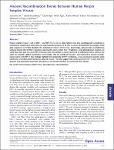Ancient Recombination Events between Human Herpes Simplex Viruses
Burrel, Sonia
Boutolleau, David
Ryu, Diane
Agut, Henri
Merkel, Kevin
Leendertz, Fabian H.
Calvignac-Spencer, Sébastien
Herpes simplex viruses 1 and 2 (HSV-1 and HSV-2) are seen as close relatives but also unambiguously considered as evolutionary independent units. Here, we sequenced the genomes of 18 HSV-2 isolates characterized by divergent UL30 gene sequences to further elucidate the evolutionary history of this virus. Surprisingly, genome-wide recombination analyses showed that all HSV-2 genomes sequenced to date contain HSV-1 fragments. Using phylogenomic analyses, we could also show that two main HSV-2 lineages exist. One lineage is mostly restricted to subSaharan Africa whereas the other has reached a global distribution. Interestingly, only the worldwide lineage is characterized by ancient recombination events with HSV-1. Our findings highlight the complexity of HSV-2 evolution, a virus of putative zoonotic origin which later recombined with its human-adapted relative. They also suggest that coinfections with HSV-1 and 2 may have genomic and potentially functional consequences and should therefore be monitored more closely.
Dateien zu dieser Publikation
Keine Lizenzangabe

